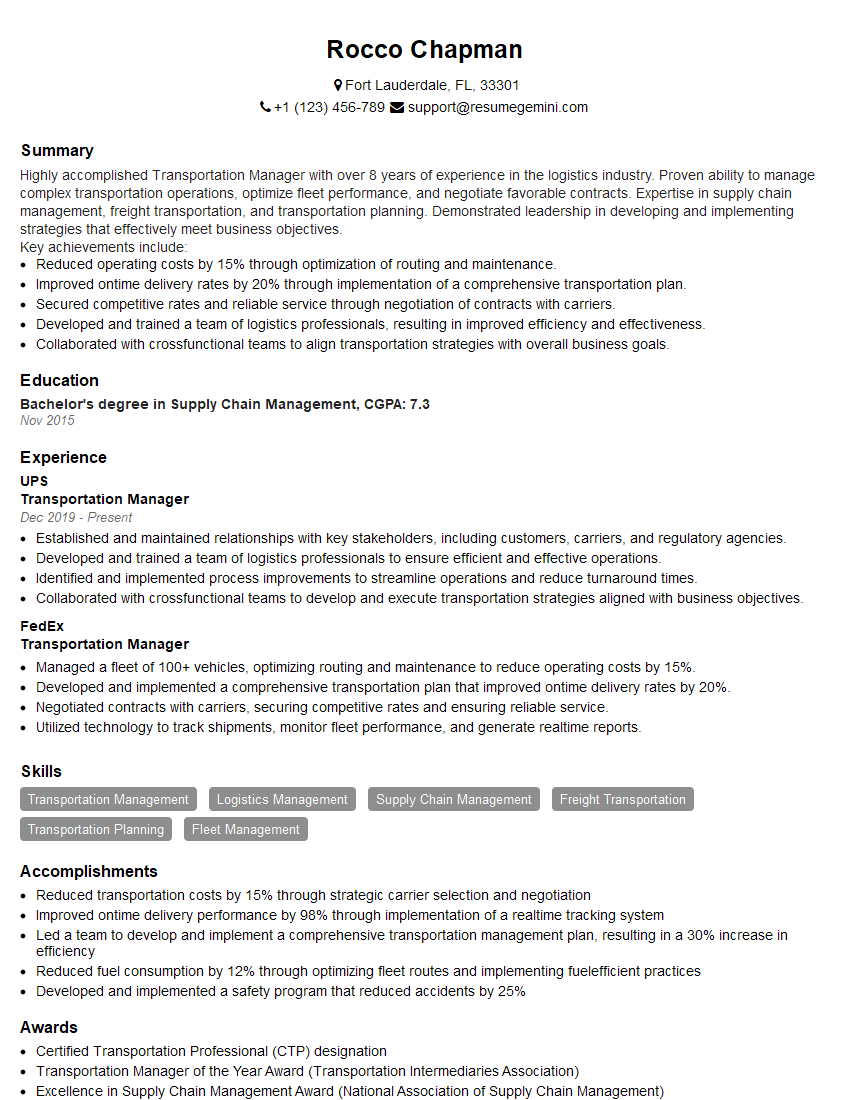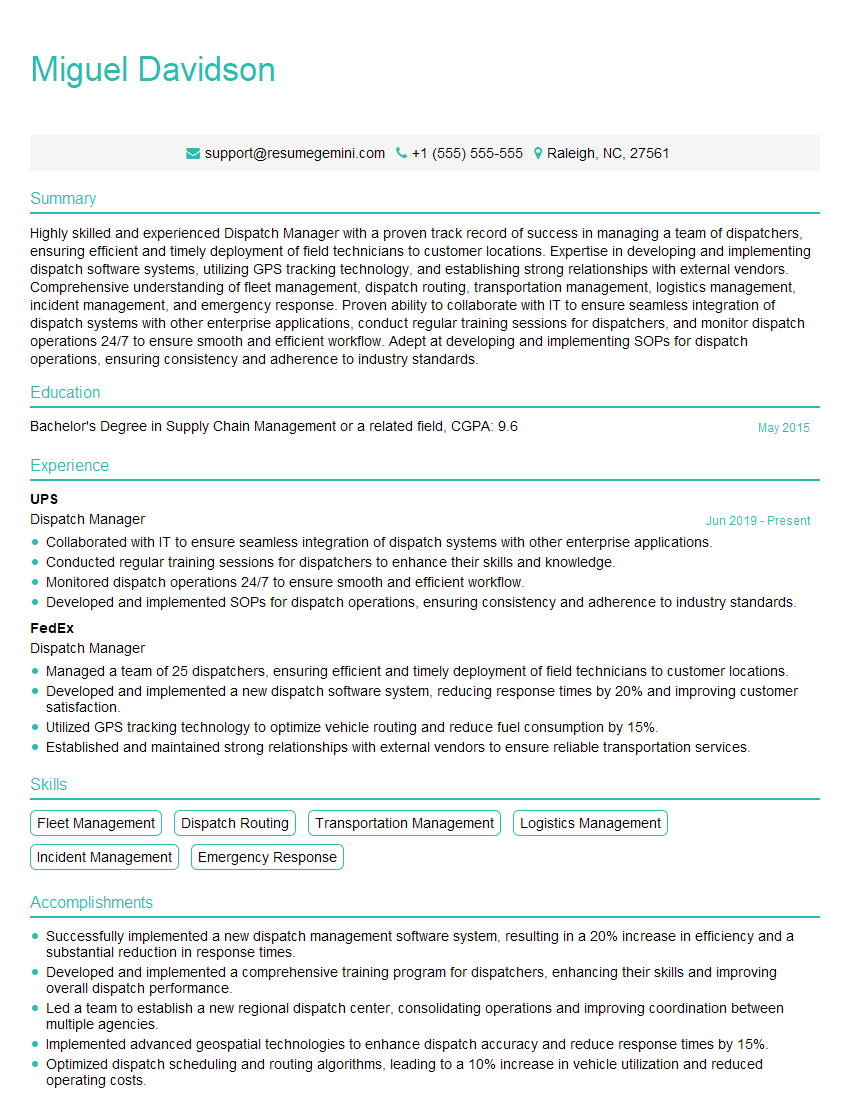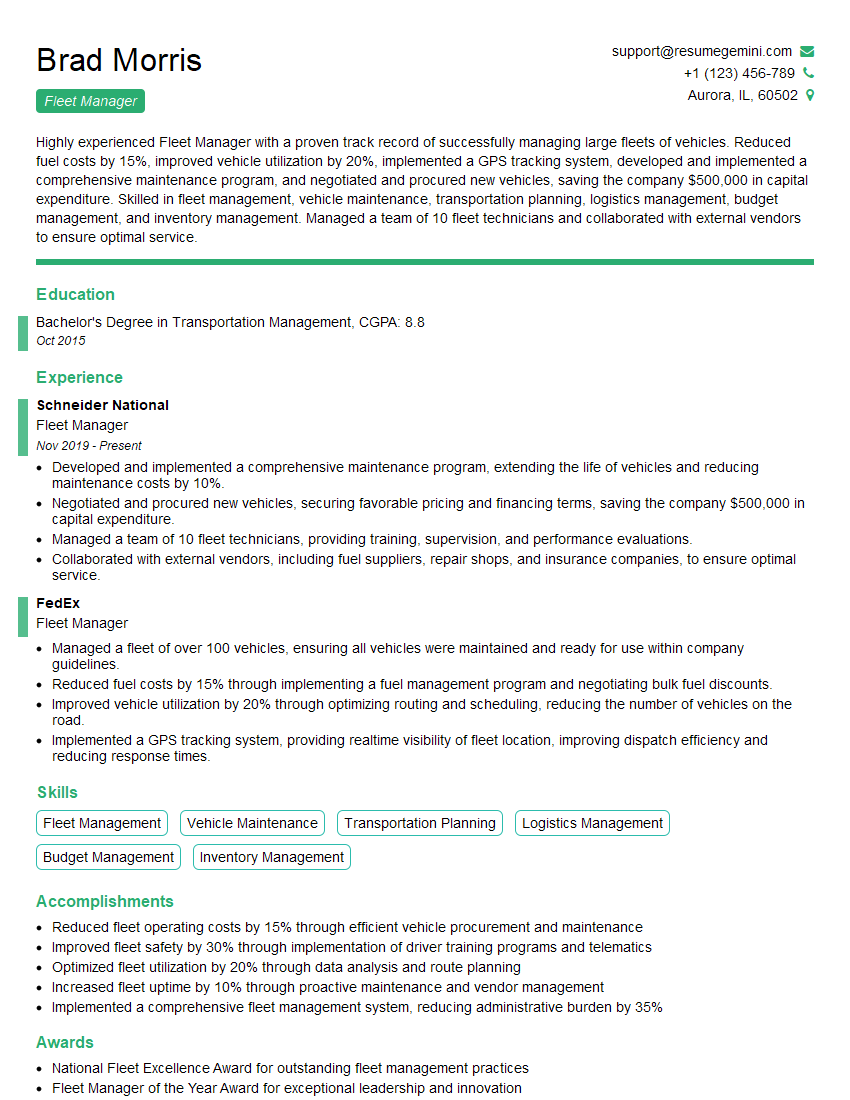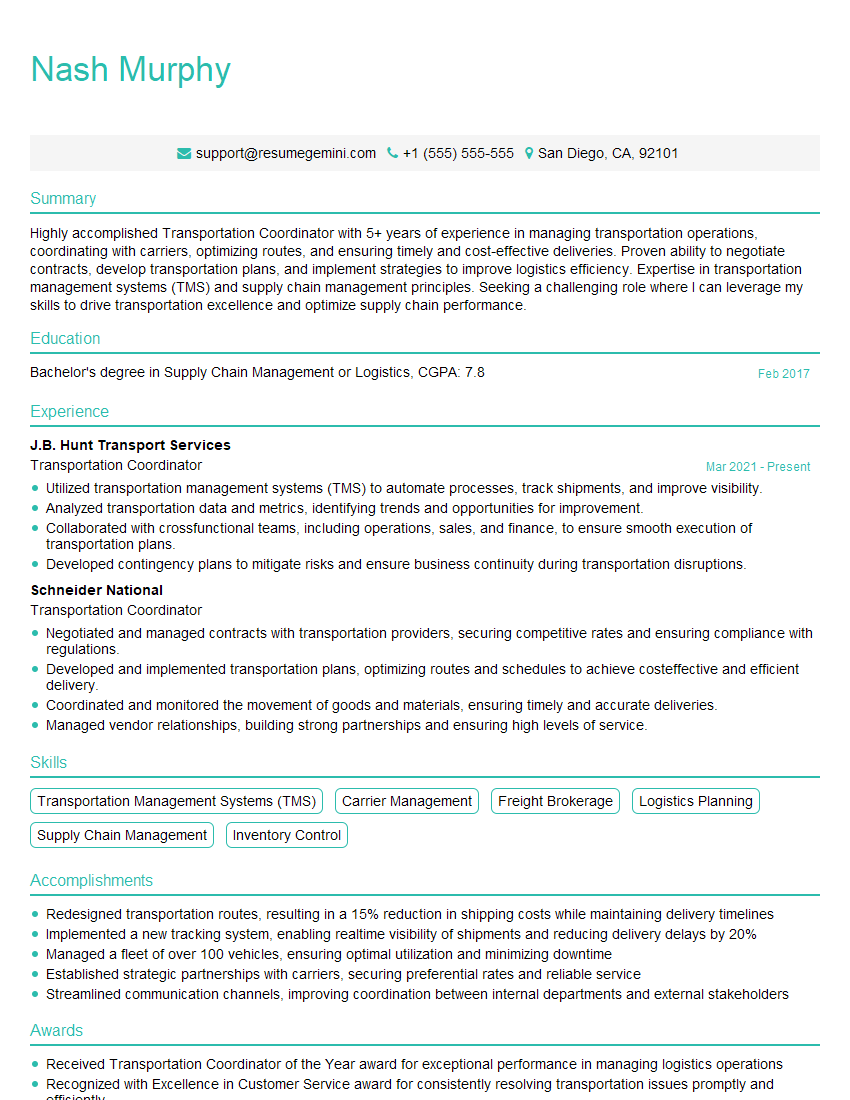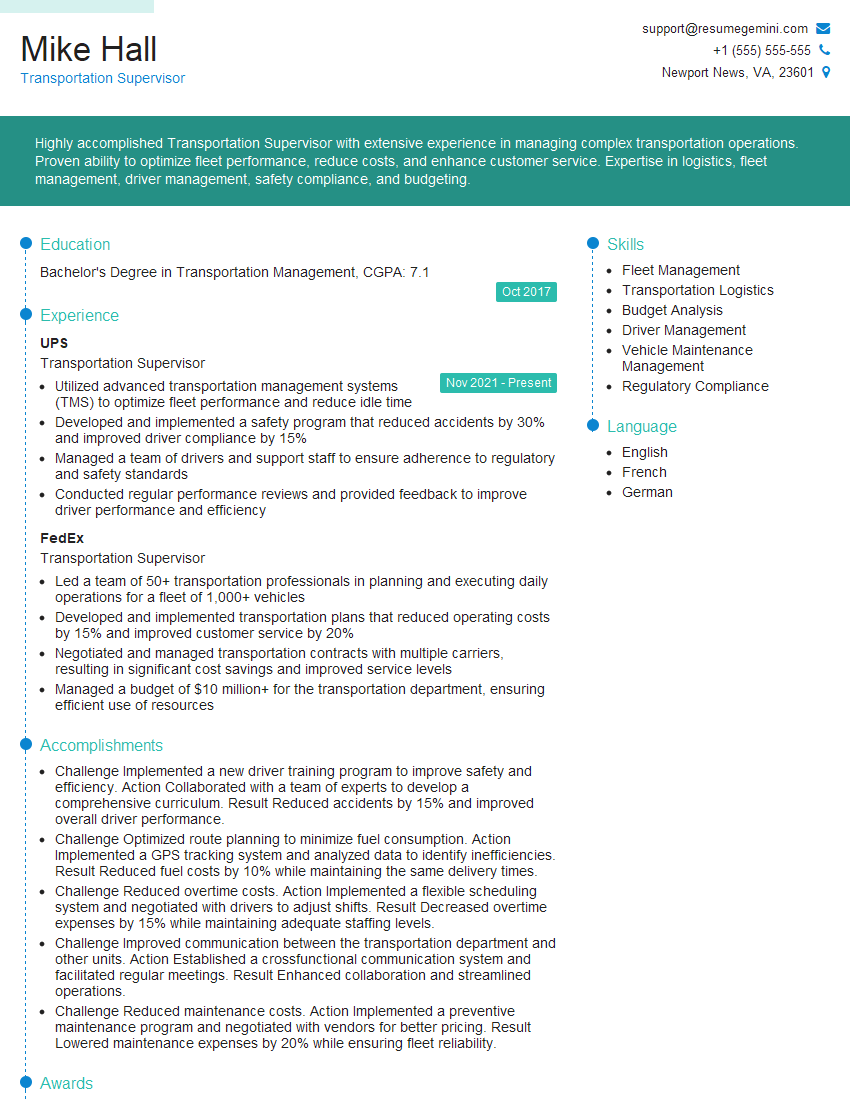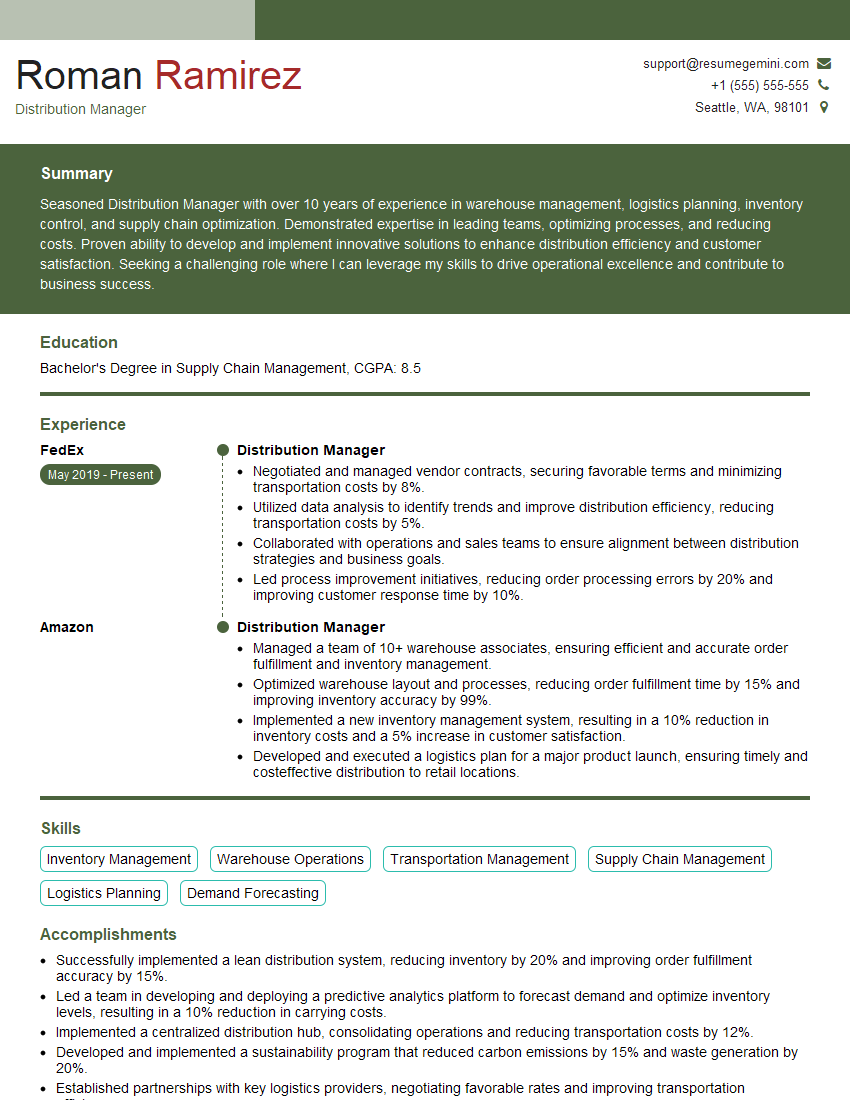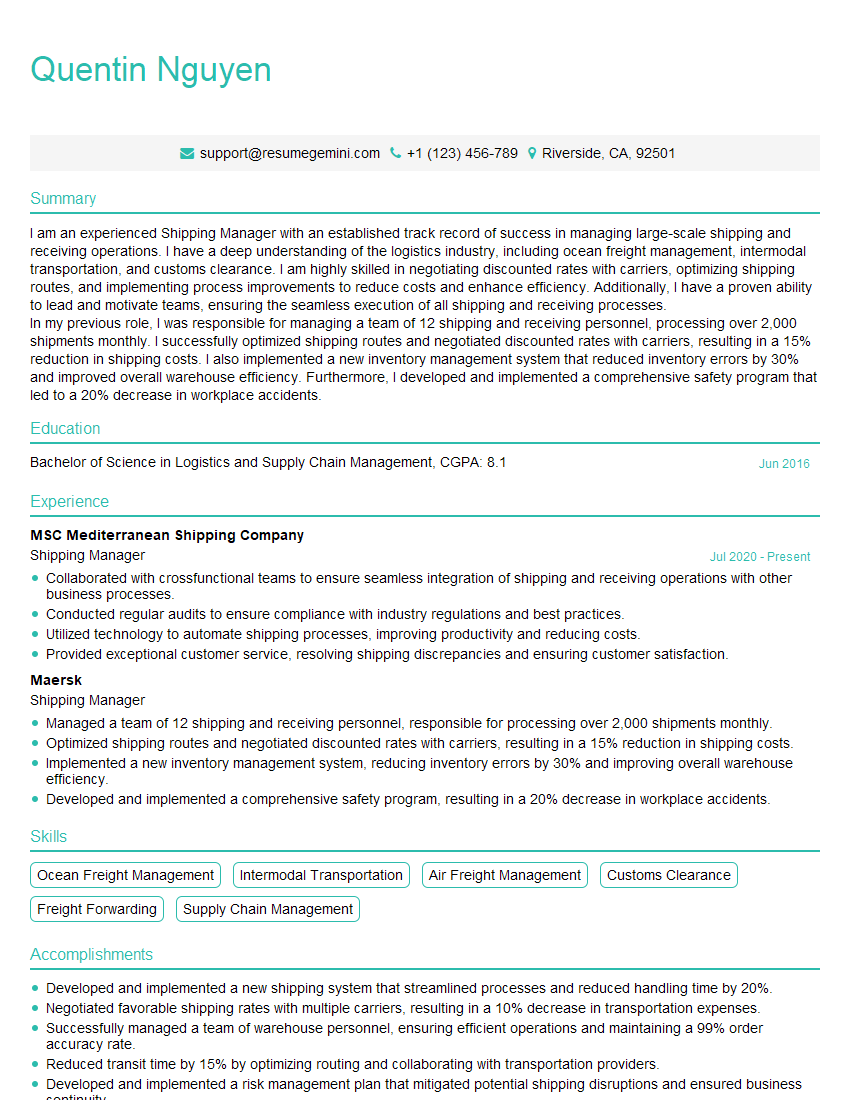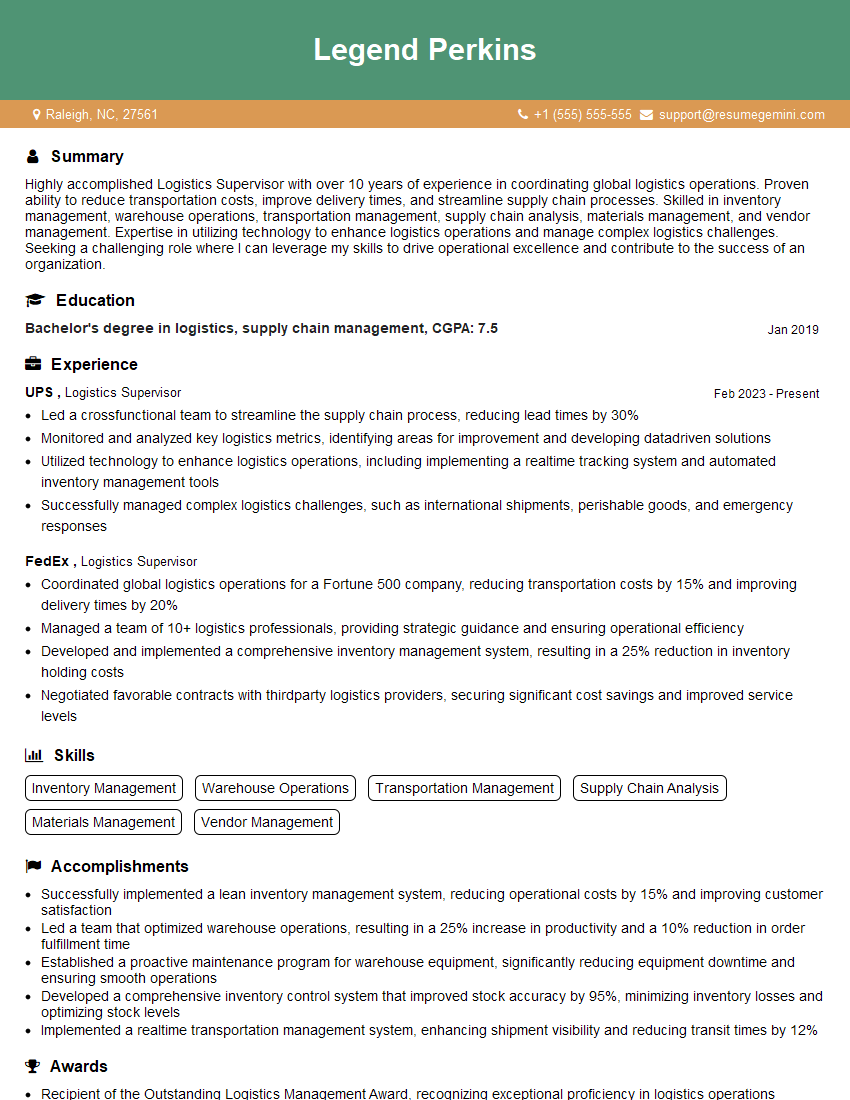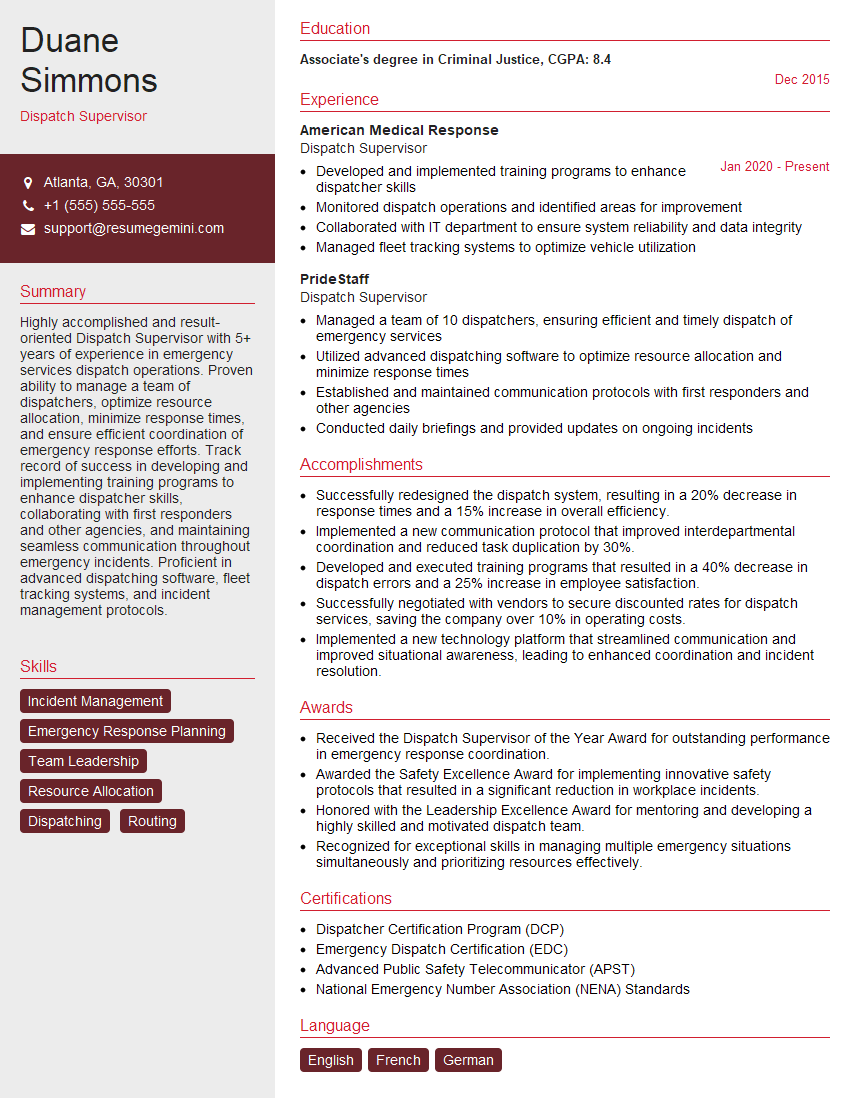The thought of an interview can be nerve-wracking, but the right preparation can make all the difference. Explore this comprehensive guide to Convoy Management interview questions and gain the confidence you need to showcase your abilities and secure the role.
Questions Asked in Convoy Management Interview
Q 1. Explain the process of planning a convoy route, considering factors like fuel efficiency, safety, and legal regulations.
Planning a convoy route is a multifaceted process requiring meticulous attention to detail. It’s not just about getting from point A to point B; it’s about optimizing for safety, efficiency, and legal compliance. Think of it like orchestrating a complex dance where each vehicle plays its part harmoniously.
- Fuel Efficiency: We utilize route-planning software that considers terrain, speed limits, and fuel consumption rates for each vehicle type. We avoid unnecessary detours and opt for routes with minimal elevation changes and favorable road surfaces. For instance, a route with consistent, high-speed limits might be preferred over one with frequent stops and starts, even if the latter is slightly shorter in distance.
- Safety: Safety is paramount. The route is carefully analyzed for potential hazards: areas with limited visibility, high accident rates, potential for ambush (depending on the operational environment), and proximity to conflict zones. We might choose a route that is longer but offers better security. We’ll also factor in rest stops and emergency service locations along the way.
- Legal Regulations: Compliance with local and international laws is critical. This includes adherence to weight limits, axle configurations, hazardous material transportation regulations, and driving hours for each driver. Our route planning software incorporates these regulations, ensuring automatic compliance check throughout the route planning process.
The entire process is iterative. We might begin with several potential routes and then refine them based on factors mentioned above using a process of elimination to find the optimal balance between these three key factors.
Q 2. Describe your experience with convoy communication systems and protocols.
My experience spans a range of convoy communication systems, from basic two-way radios to sophisticated satellite communication networks. The choice of system depends heavily on the operational environment and the size of the convoy. In simpler scenarios, dedicated VHF radios offer reliable short-range communication. For larger convoys operating over vast distances or in challenging terrains, satellite communication, such as Inmarsat, provides crucial connectivity and allows for real-time tracking and coordination.
Protocols are equally crucial. We employ clear and concise communication protocols to ensure that information flows efficiently and effectively during the operation. This includes standardized reporting procedures for incidents, driver status updates, and route changes. Think of this as a structured language that all members of the convoy must understand. For example, we might use standardized codes to report problems, such as ‘10-4’ for ‘message received’ and unique codes for specific emergencies. This minimizes ambiguity and ensures rapid response times. Regular drills and training are vital to ensure competency and rapid reaction in emergency situations.
Q 3. How do you handle unexpected delays or emergencies during a convoy operation?
Unexpected delays or emergencies are inevitable in convoy operations. Our response is based on a pre-defined emergency response plan that drills down into specific scenarios such as mechanical failures, medical emergencies, security threats, or severe weather.
- Immediate Actions: The first step is to halt the convoy in a safe location, activate emergency communication channels, and assess the situation. This might involve assessing the severity of mechanical failure and choosing between repair or replacement. If the issue threatens security, we immediately implement defensive procedures.
- Communication & Coordination: Detailed information is relayed to relevant parties (such as dispatch, emergency services, and supporting personnel). This includes the location of the incident, the nature of the problem, and the number of people affected.
- Contingency Plans: We have backup plans in place to reroute, provide alternative transport, or request additional support. This might include contacting repair services or implementing alternative communication systems in case of satellite failure.
- Post-Incident Review: After the situation is resolved, a thorough review is conducted to identify areas for improvement. This information is fed back into our training and planning process.
Imagine this like a well-rehearsed play: each member knows their part and where to go if the unexpected happens. The key is preparation and a well-defined hierarchy in the response.
Q 4. What are the key performance indicators (KPIs) you monitor to assess convoy efficiency?
Convoy efficiency is measured through several key performance indicators (KPIs). These KPIs provide insights into various aspects of the operation, enabling optimization and identifying areas for improvement.
- On-Time Arrival Rate: The percentage of convoys arriving at their destination on schedule.
- Fuel Consumption Rate: Liters per kilometer, tracked for each vehicle and the entire convoy.
- Average Speed: Maintaining a consistent speed within legal limits to balance fuel efficiency and timeliness.
- Vehicle Uptime: Minimizing downtime due to mechanical issues. A high uptime percentage indicates efficient maintenance and preparedness.
- Safety Incidents: The number of accidents or near misses per kilometer traveled.
- Driver Compliance: Adherence to driver hour regulations and other safety protocols.
By constantly monitoring these KPIs, we can identify bottlenecks and implement corrective actions. For example, if the fuel consumption rate is consistently high, we can investigate route optimization, driving techniques, or vehicle maintenance strategies.
Q 5. How do you ensure the safety and security of a convoy?
Convoy safety and security is a top priority. Our approach is multi-layered and proactive, incorporating both physical and procedural safeguards.
- Vehicle Security: Vehicles are inspected before departure to ensure they are in good working order and equipped with necessary safety features. This includes regular maintenance, tire checks, and functional communication systems.
- Driver Training: Drivers receive comprehensive training on defensive driving techniques, emergency procedures, and security protocols. This includes training on threat detection and handling of potential security breaches.
- Route Security: As discussed earlier, route planning incorporates security considerations, avoiding high-risk areas and selecting routes with better visibility and access to emergency services. This might include using armored vehicles or armed escorts in high-risk environments.
- Escort and Support: Depending on the risk assessment, convoys might be accompanied by security personnel, support vehicles, and/or military escorts.
- Communication & Coordination: Maintaining constant communication between vehicles and support personnel, enabling rapid response to threats or emergencies.
Think of it as a layered defense system, with each layer adding an additional level of protection. The more layers we have, the safer the convoy is.
Q 6. What are your methods for managing driver fatigue and ensuring compliance with driving hours regulations?
Driver fatigue is a significant safety concern. We strictly adhere to all driving hours regulations and employ several strategies to manage driver fatigue.
- Driver Hours Regulations: We meticulously track driver hours to ensure compliance with international and local regulations. This involves electronic logging devices and/or manual logs, providing an auditable trail of driving and resting times.
- Rest Breaks: Adequate rest breaks are scheduled throughout the journey, allowing drivers to rest and recuperate. These breaks are planned at secure and appropriate locations, accounting for driver needs and operational schedules.
- Driver Rotation: For longer journeys, we employ driver rotation schemes to ensure that no single driver is overworked. This is particularly important on international routes where legal compliance varies between countries.
- Fatigue Management Training: Drivers are trained to recognize the signs of fatigue in themselves and their colleagues and to take appropriate actions, such as taking extra rest breaks or reporting fatigue to management.
- Technology: We use telematics systems to monitor driver behavior and identify potential signs of fatigue, such as erratic driving patterns.
Addressing driver fatigue is not simply a matter of compliance; it’s essential to ensure safety and prevent accidents. Our approach is proactive and multi-faceted to support driver well-being and operational efficiency.
Q 7. Describe your experience with convoy tracking and monitoring technologies.
Convoy tracking and monitoring technologies are crucial for efficient and safe operations. We use a variety of systems, depending on the needs of the operation and the environment.
- GPS Tracking: Real-time GPS tracking provides location data for each vehicle in the convoy, enabling monitoring of speed, direction, and distance traveled. This allows supervisors to quickly identify any deviations from the planned route.
- Telematics Systems: More advanced telematics systems provide data on various vehicle parameters, such as fuel consumption, engine performance, and driver behavior. This data is invaluable for optimizing efficiency and safety.
- Satellite Communication: Satellite communication systems enable seamless communication across vast distances and provide reliable connectivity, even in areas with limited cellular coverage. This is crucial for coordinating the convoy’s movements and responding to emergencies.
- Data Analytics: We use data analytics tools to process the data collected from these tracking and monitoring systems. This enables us to identify trends, optimize routes, improve fuel efficiency, and enhance safety protocols.
These technologies provide a comprehensive overview of the convoy’s status, enabling proactive management and quick response to potential problems. We treat this data as a critical element of our decision-making process.
Q 8. How do you manage fuel consumption and minimize costs for a convoy?
Fuel efficiency is paramount in convoy management, directly impacting operational costs and environmental responsibility. Minimizing fuel consumption requires a multifaceted approach.
- Optimized Driving Techniques: Training drivers in fuel-efficient driving practices, such as maintaining consistent speeds, avoiding sudden acceleration and braking, and utilizing momentum, significantly reduces fuel use. Think of it like gliding on a bicycle – less energy wasted means more distance covered.
- Route Planning & Optimization: Carefully planned routes considering terrain, traffic patterns, and fuel stop locations are crucial. Software tools can analyze different routes to identify the most fuel-efficient option, accounting for factors like elevation changes and road conditions.
- Vehicle Maintenance: Regularly scheduled maintenance ensures vehicles are operating at peak efficiency. Properly inflated tires, well-tuned engines, and aerodynamic modifications all contribute to reduced fuel consumption. Neglecting maintenance is like driving a car with a flat tire – inefficient and costly.
- Load Management: Optimizing cargo distribution to minimize weight and aerodynamic drag improves fuel economy. Think of it like packing a suitcase – efficiently distributed weight minimizes unnecessary strain.
- Fuel Procurement Strategy: Negotiating favorable fuel prices with suppliers and strategically timing fuel stops to capitalize on price fluctuations can yield significant savings. It’s like shopping around for the best grocery deals – smart planning saves money.
Q 9. Explain your experience with different types of convoys (e.g., military, humanitarian, commercial).
My experience encompasses a wide range of convoy operations, each with its unique challenges and demands.
- Military Convoys: I’ve been involved in managing logistical support convoys, focusing on security protocols, route planning in challenging terrains (like mountainous regions or deserts), and ensuring the safe and timely delivery of supplies and equipment to forward operating bases. Security and adherence to strict operational procedures were paramount.
- Humanitarian Convoys: In this context, the focus shifts to delivering aid effectively to disaster-stricken areas. Coordination with local authorities, navigating damaged infrastructure, and ensuring the safety of both personnel and aid are key considerations. Speed and efficiency are crucial, but so is sensitivity to the needs of the affected population.
- Commercial Convoys: These often involve the transportation of goods over long distances, with an emphasis on cost-effectiveness and adherence to delivery schedules. Route optimization, driver management, and efficient logistics are critical for maximizing profitability.
Each type of convoy requires a tailored approach, but the core principles of effective communication, meticulous planning, and proactive risk management remain constant.
Q 10. How do you handle conflicts or disagreements among convoy drivers?
Conflicts among drivers are addressed promptly and fairly to maintain convoy cohesion and efficiency. My approach is based on open communication and conflict resolution strategies.
- Open Dialogue: I encourage drivers to openly communicate concerns or disagreements. A safe space for expressing concerns is essential.
- Mediation: If a conflict arises, I act as a mediator, facilitating a discussion to understand each driver’s perspective and find a mutually agreeable solution. This requires active listening and impartiality.
- Disciplinary Action: In cases of serious misconduct or repeated violations, disciplinary action is taken according to established protocols. Consistency in enforcement is key.
- Team Building Exercises: Proactive team-building exercises before the convoy commences can foster a sense of camaraderie and shared purpose, reducing the likelihood of interpersonal conflicts.
The goal is to resolve conflicts quickly and effectively to prevent them from impacting the convoy’s mission or safety.
Q 11. Describe your process for pre-trip inspections and maintenance of convoy vehicles.
Pre-trip inspections and maintenance are non-negotiable for ensuring the safety and reliability of the convoy. My process is comprehensive and systematic.
- Vehicle Checklists: Standardized checklists ensure consistent and thorough inspections of all vehicle systems, including brakes, tires, lights, fluids, and cargo securing mechanisms. Each driver is responsible for completing a checklist before departure.
- Scheduled Maintenance: Regular preventative maintenance is scheduled to minimize breakdowns and malfunctions. This includes oil changes, filter replacements, and inspections of key components.
- Driver Training: Drivers receive extensive training on vehicle maintenance and basic repairs. They are empowered to perform simple checks and address minor issues independently.
- Record Keeping: Meticulous records of inspections and maintenance are maintained to track vehicle history and identify potential problems early.
- Emergency Repairs: The convoy carries essential spare parts and tools to handle minor repairs on the road, minimizing downtime.
This structured approach proactively mitigates mechanical issues, reducing the risk of breakdowns and ensuring the convoy’s operational readiness.
Q 12. How do you maintain communication and coordination among multiple vehicles in a convoy?
Maintaining communication and coordination among multiple vehicles is crucial for safety and efficiency. This is achieved through a combination of technologies and established protocols.
- Two-Way Radios: Essential for real-time communication between vehicles and the convoy leader, enabling immediate response to incidents or changes in conditions.
- Satellite Communication: Provides backup communication and location tracking, especially in remote or areas with limited cellular coverage.
- Convoy Management Software: Software platforms allow real-time tracking of vehicle locations, speeds, and fuel levels, facilitating dynamic route adjustments and efficient resource allocation.
- Established Protocols: Clear communication protocols are established and rigorously followed. These include procedures for reporting incidents, requesting assistance, and managing changes to the convoy’s plan.
- Regular Check-ins: Scheduled check-ins ensure all vehicles are accounted for and any issues are addressed promptly.
These measures work together to create a robust and responsive communication network within the convoy.
Q 13. What are your strategies for navigating challenging terrain or adverse weather conditions?
Navigating challenging terrain or adverse weather conditions requires meticulous planning, skilled driving, and adaptive strategies.
- Route Planning: Thorough route planning considers terrain specifics, weather forecasts, and potential hazards. Alternative routes are identified to accommodate unexpected circumstances. This is like planning a hiking trip – knowing the terrain and having backup plans is essential.
- Vehicle Preparation: Vehicles are equipped with appropriate gear for the expected conditions, including all-terrain tires, chains, and extra fuel. It’s like preparing for a winter storm – extra supplies are critical.
- Driver Training: Drivers are trained to handle challenging conditions safely and efficiently. This includes defensive driving techniques, recovery procedures for stuck vehicles, and emergency response protocols. This is like learning survival skills – knowing what to do in an emergency is crucial.
- Communication: Enhanced communication protocols are used to address unforeseen challenges promptly. Regular updates on conditions and potential hazards keep everyone informed.
- Convoy Formation: Convoy formation adapts to conditions, with adjustments to spacing and speed to maintain safety and control.
A flexible and adaptable approach is key to successfully navigating difficult conditions while ensuring the safety of personnel and equipment.
Q 14. Explain your experience with convoy scheduling and resource allocation.
Convoy scheduling and resource allocation are critical for optimizing efficiency and minimizing costs. My approach involves a detailed planning process.
- Demand Forecasting: Accurate forecasting of transportation needs is crucial. This involves considering factors like volume, weight, delivery deadlines, and potential disruptions.
- Route Optimization: Sophisticated software tools are used to optimize routes, considering factors like distance, traffic, and fuel costs. This minimizes travel time and fuel consumption.
- Resource Allocation: This includes the strategic assignment of drivers, vehicles, and support personnel to maximize efficiency and minimize downtime. Skill matching is crucial.
- Scheduling Software: Specialized software helps manage schedules, track progress, and adapt to unexpected delays or changes in demand. This allows for real-time adjustments and proactive problem-solving.
- Budget Management: Detailed budgets track expenses associated with fuel, maintenance, personnel, and other operational costs. This ensures cost-effectiveness and efficient resource utilization.
Efficient scheduling and resource allocation are essential for both cost-effectiveness and the timely completion of the convoy’s mission.
Q 15. How do you ensure compliance with all relevant legal and regulatory requirements?
Ensuring compliance with all relevant legal and regulatory requirements in convoy management is paramount. This involves a multi-faceted approach focusing on meticulous documentation, adherence to international and local laws, and proactive risk management.
- Regular Audits: We conduct internal audits at predetermined intervals to verify that our operations align with all applicable regulations, such as those concerning driver licensing, vehicle maintenance, hazardous materials transportation, and international trade laws. Any discrepancies are immediately addressed with corrective actions documented.
- Driver Training: Our drivers undergo rigorous training covering legal compliance, defensive driving, and emergency procedures. This ensures that they understand and adhere to all traffic laws and regulations in the regions they operate.
- Documentation: We maintain detailed records of vehicle maintenance, driver hours of service, cargo manifests, and permits. This meticulous record-keeping allows for swift responses to audits and investigations, demonstrating transparency and compliance.
- Staying Updated: We actively monitor changes in legislation and regulations through subscriptions to relevant publications and participation in industry conferences. This proactive approach ensures that our operations remain current and compliant with evolving legal frameworks.
For instance, in a recent operation through a particularly strict region, we discovered a minor discrepancy in our permit documentation. By promptly addressing this, we avoided potential delays and significant penalties. This highlights the importance of proactive and consistent compliance monitoring.
Career Expert Tips:
- Ace those interviews! Prepare effectively by reviewing the Top 50 Most Common Interview Questions on ResumeGemini.
- Navigate your job search with confidence! Explore a wide range of Career Tips on ResumeGemini. Learn about common challenges and recommendations to overcome them.
- Craft the perfect resume! Master the Art of Resume Writing with ResumeGemini’s guide. Showcase your unique qualifications and achievements effectively.
- Don’t miss out on holiday savings! Build your dream resume with ResumeGemini’s ATS optimized templates.
Q 16. Describe your experience with risk assessment and mitigation strategies for convoy operations.
Risk assessment and mitigation in convoy operations is a critical aspect of ensuring safety and mission success. We employ a structured approach that includes identifying potential hazards, assessing their likelihood and severity, and developing appropriate mitigation strategies.
- Hazard Identification: This involves identifying potential risks such as road conditions, security threats, weather patterns, mechanical failures, and human error. This is often done through a combination of pre-mission planning, using geographic information systems (GIS) data, and local intelligence gathering.
- Risk Assessment: Each identified hazard is analyzed based on its probability of occurrence and the potential severity of its consequences. This often employs a matrix system for easier visualization and prioritization.
- Mitigation Strategies: Based on the risk assessment, appropriate mitigation strategies are developed and implemented. These may include selecting safer routes, using armored vehicles, increasing security personnel, establishing communication protocols, carrying spare parts, or implementing contingency plans for different scenarios.
For example, during a convoy in a region with known insurgent activity, we employed a layered security approach. This included advance reconnaissance, armed security personnel, communication relays, and pre-planned escape routes. This multi-layered approach allowed us to effectively mitigate the risk of attack, successfully completing the mission.
Q 17. How do you handle incidents or accidents involving convoy vehicles?
Handling incidents or accidents involving convoy vehicles requires a swift and organized response to minimize further damage, ensure the safety of personnel, and comply with relevant legal and regulatory requirements.
- Immediate Response: Our protocol involves immediately contacting emergency services and initiating our internal emergency response plan. This plan includes procedures for securing the scene, providing first aid, and communicating with relevant authorities.
- Investigation: A thorough investigation is launched to determine the cause of the accident. This investigation may involve gathering evidence, interviewing witnesses, and analyzing vehicle data recorders (black boxes).
- Reporting: All incidents are documented and reported to relevant stakeholders, including insurance companies, regulatory bodies, and clients. Transparency and accurate reporting are crucial during this stage.
- Remedial Actions: Based on the investigation’s findings, remedial actions are implemented to prevent future occurrences. This may include enhanced driver training, improved vehicle maintenance, or revisions to operational procedures.
For example, in an instance of a minor collision, our immediate response ensured that the scene was secure and medical assistance was provided. The subsequent investigation identified a lapse in driver training, leading to revised training protocols, preventing similar incidents in the future.
Q 18. What are your methods for optimizing convoy speed and arrival times?
Optimizing convoy speed and arrival times requires a delicate balance between speed and safety. We employ various methods to maximize efficiency without compromising security.
- Route Planning: We use advanced route planning software that considers factors such as road conditions, traffic patterns, security risks, and weather forecasts. This helps to select the optimal route with minimal delays.
- Speed Management: Speed limits are carefully determined based on road conditions, vehicle capabilities, and security considerations. We emphasize consistent and safe speeds rather than maximum speed for overall efficiency.
- Vehicle Spacing: Appropriate spacing between vehicles is maintained to ensure safety and prevent accidents. This spacing can be adjusted based on road conditions and security threats.
- Communication: Clear and constant communication between the lead vehicle and trailing vehicles ensures that the convoy moves as a coordinated unit. This helps in anticipating and responding to challenges promptly.
For example, using real-time traffic data and route optimization software, we were able to successfully navigate through unexpected congestion, minimizing delays and arriving at our destination within the allotted time.
Q 19. How do you manage the logistics of supplying and resupplying a convoy?
Managing the logistics of supplying and resupplying a convoy requires meticulous planning and execution. This involves anticipating needs, coordinating transportation, and establishing secure resupply points.
- Needs Assessment: We carefully assess the convoy’s fuel, water, food, and equipment requirements based on the duration of the journey, the number of personnel, and environmental conditions.
- Resupply Points: Secure and well-stocked resupply points are established along the route. This often involves coordinating with local authorities and security personnel.
- Transportation: We utilize reliable transportation methods to deliver supplies to the resupply points. This could involve using dedicated support vehicles or engaging third-party logistics providers.
- Inventory Management: Strict inventory management ensures that supplies are properly accounted for and distributed efficiently to minimize waste and shortages.
For example, during a long-distance convoy, we established pre-arranged resupply points at regular intervals. This allowed for efficient refueling, restocking of supplies, and ensured that personnel had access to necessary provisions throughout the journey.
Q 20. What software or tools do you use for convoy management?
We utilize a range of software and tools to enhance our convoy management capabilities. These tools streamline operations, enhance safety, and improve efficiency.
- GPS Tracking Systems: These systems provide real-time tracking of convoy vehicles, allowing us to monitor their location, speed, and overall status. This data helps in efficient route planning, timely response to incidents, and optimized resource allocation.
- Communication Systems: Secure communication systems, such as satellite phones and radios, enable constant communication between convoy vehicles and the control center. This ensures coordinated movement and enables quick responses to unforeseen circumstances.
- Route Planning Software: We utilize advanced route planning software that considers multiple factors to determine the optimal route. This ensures that the convoy takes the safest and most efficient route.
- Fleet Management Software: This software aids in managing vehicle maintenance schedules, fuel consumption, and driver hours of service, which contributes to efficiency and regulatory compliance.
For instance, our GPS tracking system recently alerted us to a vehicle that had deviated from the planned route. This allowed for immediate intervention, preventing a potential accident due to poor road conditions.
Q 21. How do you adapt convoy plans to changing circumstances or unexpected events?
Adapting convoy plans to changing circumstances requires flexibility, preparedness, and effective communication. Our approach centers on proactive planning, robust contingency plans, and a flexible decision-making process.
- Contingency Planning: We develop comprehensive contingency plans to address potential unforeseen events such as mechanical failures, security threats, adverse weather conditions, and road closures.
- Real-time Monitoring: Constant monitoring of weather, security, and road conditions allows for timely adjustments to the planned route and schedule.
- Communication Protocols: Clear and efficient communication protocols ensure that all members of the convoy are informed of any changes and adjustments to the plan.
- Decision-Making Process: A clear and decisive decision-making process enables swift responses to unexpected situations and allows for effective adaptation to changing circumstances.
For instance, when encountering an unexpected road closure, we immediately activated our contingency plan. This involved re-routing the convoy via an alternative route, identified through real-time monitoring and communication with our control center, thus minimizing the delay and ensuring the safe delivery of the goods.
Q 22. Explain your understanding of convoy security protocols and best practices.
Convoy security protocols are crucial for ensuring the safety and efficient movement of vehicles. Best practices encompass a multi-layered approach, combining proactive planning with reactive measures. This involves meticulous route planning, considering potential threats and vulnerabilities like terrain, weather conditions, and known high-risk areas.
Before the convoy departs: Detailed risk assessments are conducted. We’d meticulously map the route, identifying potential ambush points, checkpoints, or areas with poor communication coverage. This information is shared with all drivers during pre-convoy briefings. Secure communication systems, resistant to jamming, are essential. Vehicle checks and maintenance are also critical – ensuring that all vehicles are in optimal condition and equipped with emergency supplies.
During the convoy: We employ staggered formations, with lead and rear security vehicles providing constant surveillance. Drivers are trained to maintain situational awareness, constantly scanning their surroundings for suspicious activity. Communication protocols are strictly followed, enabling quick responses to any incident. This includes standardized radio codes for reporting issues or potential threats. Regular check-ins ensure constant monitoring of the convoy’s status and position. Finally, escort vehicles, both armed and unarmed, may be utilized depending on the risk level of the operation.
After the convoy: A debriefing session is mandatory. This provides an opportunity to review the journey, identify any weaknesses in the security protocols, and learn from potential near misses. This continuous improvement cycle enhances safety and efficiency.
Q 23. Describe your experience with driver training and performance management within a convoy.
Driver training is the cornerstone of effective convoy management. I’ve overseen extensive training programs covering defensive driving techniques, convoy formations, emergency procedures, communication protocols, and security awareness. This includes both classroom instruction and practical, hands-on training exercises simulating various challenging scenarios, such as breakdowns, sudden threats, and navigating hazardous conditions.
Performance management is ongoing. We use a combination of methods, including regular performance reviews, tracking key performance indicators (KPIs) like adherence to speed limits, maintaining formation, and timely reporting of incidents. Real-time tracking systems provide data on driver behavior, enabling us to identify areas needing improvement. Positive reinforcement and corrective feedback are integral parts of the process, ensuring continuous professional development. For example, exceptional performance is rewarded through recognition programs, while performance deficiencies result in targeted retraining or coaching.
Q 24. How do you measure the effectiveness of your convoy management strategies?
Measuring the effectiveness of convoy management strategies relies on several key indicators. Primarily, we track the safety record: the number of accidents, incidents, or near misses. A reduction in these metrics directly indicates the effectiveness of our strategies.
We also assess on-time performance, evaluating how effectively convoys reach their destination within the scheduled timeframe. Delays often point to operational inefficiencies or unforeseen circumstances requiring adjustment.
Furthermore, we measure fuel efficiency and operational costs. Optimized routes and driving practices can significantly reduce expenses.
Finally, driver satisfaction surveys provide valuable feedback on the training programs, communication clarity, and overall working environment. High driver satisfaction correlates with improved performance and lower turnover rates.
Q 25. What are the challenges of managing large or complex convoys?
Managing large or complex convoys presents unique challenges. The sheer number of vehicles and personnel increases the risk of communication breakdowns, logistical complications, and coordination difficulties. For instance, maintaining formation and ensuring safe distances between vehicles becomes exponentially more difficult.
Communication: Clear, concise, and efficient communication channels are paramount. Specialized communication systems are needed, capable of handling simultaneous transmissions from numerous vehicles. Establishing clear chain of command and responsibility helps streamline information flow and decision-making.
Logistics: Coordinating fuel stops, rest breaks, and maintenance schedules for a large number of vehicles requires precise planning and robust logistical support. Unexpected delays or breakdowns in one vehicle can have a cascading effect on the entire convoy.
Security: The larger the convoy, the more vulnerable it might be to attacks. Effective security protocols are even more critical, requiring a more robust security detail and enhanced situational awareness.
Route planning: Choosing appropriate routes that can accommodate large convoys, avoiding narrow roads or congested areas, requires careful consideration.
Q 26. Describe a time you had to make a difficult decision regarding convoy safety or efficiency.
During a particularly challenging convoy operation in a volatile region, we faced an unforeseen roadblock caused by a political demonstration. The initial plan was to wait it out, but intelligence suggested the situation could escalate into violence. This presented a difficult decision: wait, risking escalation and endangering the convoy, or attempt a detour through an uncharted, potentially hazardous route.
After careful consideration of all risks, factoring in intelligence reports, the convoy’s size, the condition of our vehicles, and the potential consequences of both options, I decided to proceed with the detour. This required communicating clearly and calmly with all drivers, ensuring they understood the rationale and the plan. We successfully navigated the detour, minimizing risk, and arriving at our destination safely albeit with some delays. The decision highlighted the importance of adaptability, sound judgement, and efficient communication under pressure.
Q 27. How do you handle communication with stakeholders (e.g., clients, government agencies)?
Effective communication with stakeholders is paramount. I utilize a variety of methods tailored to the specific audience and situation.
With clients, I focus on transparency, regular updates on convoy progress and safety, and proactive communication about potential delays or challenges. This includes regular briefings and detailed reports with clear visuals and concise language.
Communication with government agencies involves adhering to their protocols, providing necessary documentation, and proactively addressing any safety or security concerns. This might involve liaising with security personnel, obtaining necessary permits, and adhering to specific regulatory guidelines. In all cases, clear and concise communication that is easy to understand is key. This includes using simple language, avoiding jargon, and utilizing appropriate communication channels.
Q 28. What are your plans for continuing your professional development in Convoy Management?
My professional development plan in convoy management centers around continuous learning and improvement. I plan to pursue advanced training in crisis management and risk assessment, enhancing my ability to proactively anticipate and mitigate potential threats.
I also aim to expand my knowledge in logistical technologies, particularly those related to real-time tracking, communication systems, and fleet management software. Staying current with emerging technologies is crucial to optimize operational efficiency and safety. Finally, I plan to actively participate in professional networking events and conferences to stay informed of industry best practices and engage with fellow professionals.
Key Topics to Learn for Convoy Management Interview
- Route Planning and Optimization: Understanding algorithms and software used for efficient route planning, considering factors like distance, time, fuel consumption, and regulations. Practical application involves analyzing different route options and justifying the selection based on data-driven insights.
- Fleet Management & Tracking: Knowledge of GPS tracking systems, telematics, and data analysis to monitor vehicle performance, driver behavior, and overall fleet efficiency. Practical application involves interpreting data to identify areas for improvement in fuel efficiency, driver safety, and maintenance scheduling.
- Logistics and Supply Chain Management: Understanding the principles of supply chain management within the context of convoy operations, including inventory management, resource allocation, and risk mitigation. Practical application involves designing and implementing strategies to ensure timely delivery of goods while minimizing disruptions.
- Communication and Coordination: Understanding the importance of clear and efficient communication among drivers, dispatchers, and other stakeholders within a convoy. Practical application involves developing strategies for real-time communication and problem-solving in challenging situations.
- Safety and Regulatory Compliance: Deep understanding of relevant safety regulations and procedures for operating convoys, including driver training, vehicle maintenance, and emergency response protocols. Practical application involves designing and implementing safety measures to minimize risks and ensure compliance.
- Risk Assessment and Mitigation: Identifying potential risks associated with convoy operations (e.g., mechanical failures, security threats, weather conditions) and developing strategies for mitigation. Practical application includes creating contingency plans and evaluating the effectiveness of different risk management approaches.
Next Steps
Mastering Convoy Management opens doors to exciting career opportunities in logistics, transportation, and supply chain management. It demonstrates valuable skills in planning, coordination, problem-solving, and data analysis, highly sought after in today’s competitive job market. To significantly improve your job prospects, creating an ATS-friendly resume is crucial. ResumeGemini is a trusted resource to help you build a professional and impactful resume that highlights your skills and experience effectively. Examples of resumes tailored to Convoy Management are available to help you craft a compelling application.
Explore more articles
Users Rating of Our Blogs
Share Your Experience
We value your feedback! Please rate our content and share your thoughts (optional).
What Readers Say About Our Blog
Hello,
We found issues with your domain’s email setup that may be sending your messages to spam or blocking them completely. InboxShield Mini shows you how to fix it in minutes — no tech skills required.
Scan your domain now for details: https://inboxshield-mini.com/
— Adam @ InboxShield Mini
Reply STOP to unsubscribe
Hi, are you owner of interviewgemini.com? What if I told you I could help you find extra time in your schedule, reconnect with leads you didn’t even realize you missed, and bring in more “I want to work with you” conversations, without increasing your ad spend or hiring a full-time employee?
All with a flexible, budget-friendly service that could easily pay for itself. Sounds good?
Would it be nice to jump on a quick 10-minute call so I can show you exactly how we make this work?
Best,
Hapei
Marketing Director
Hey, I know you’re the owner of interviewgemini.com. I’ll be quick.
Fundraising for your business is tough and time-consuming. We make it easier by guaranteeing two private investor meetings each month, for six months. No demos, no pitch events – just direct introductions to active investors matched to your startup.
If youR17;re raising, this could help you build real momentum. Want me to send more info?
Hi, I represent an SEO company that specialises in getting you AI citations and higher rankings on Google. I’d like to offer you a 100% free SEO audit for your website. Would you be interested?
Hi, I represent an SEO company that specialises in getting you AI citations and higher rankings on Google. I’d like to offer you a 100% free SEO audit for your website. Would you be interested?
good


